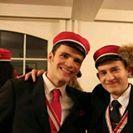Search the Community
Showing results for tags 'history'.
-
So, I've been binge watching a lot on music history and the development of compositional styles from pretonal to modern day. I came across these interesting lectures by Leonard Bernstein -yes, the great conductor and composer from the latter half of the 20th century. To add some context of my interest in this stuff.... these lectures were done in 1973 -just 7 years before my birth! So, they are still quite current within the musical discussion. To sum it up: most composers see a dichotomy of crisis within the 20th century that has continued into the 21st century. As Bernstein states within these lectures, this led to a split in aesthetics with Stravinsky on one side and Schoenberg on the other. We see this split today (despite Stravinsky's later adoption of serial technique late in his life). Bernstein also, rightly, predicts an 'age of eclecticism' in music. His prediction -which does appear to have come true- isn't coupled with any discussion of whether it is a positive or negative addition to our high art form. Here's the link! Let the discussion begin!
- 32 replies
-
- 1
-

-
Hello all, I have been absent for a few months, spending most of my evenings working on this project. 2014 was the thousandth anniversary of Irish High King Brian Boru's death. I decided to look his history up in detail and subsequently (around this time last year) realised it would be great material for music. I wanted to explicitly tell his story and the best way I found to do that was by means of a cantata. I wrote the libretto myself without even trying poetry and other niceties (as I said, my goal is only to get the story across, almost as if the piece was a film score). However, any comments on the text are welcome as well. The job is by no means finished, in fact I'd say this is about half the final length, but I would like to have your opinions on what it sounds like so far. Cheers, Marc
-
JOAN BAEZ AND ME More than three years ago a film was released on the life of Joan Baez(1941- ). How Sweet the Sound came to television today in Tasmania.1 Baez rose to fame in 1959 when I was 15, and she only 19. I was a person of fame, too, but only in a little town in Ontario, and nowhere else. Her first major performance was at the Newport Folk Festival, the same year I joined the Baha’i Faith. Baez was a Quaker and a pacifist. I am not a pacifist and our forms of social activism are very different. I have always loved her singing from her first albums which appeared in 1960, 1961, and 1962 when I was finishing high school. In 1962, when I began my travelling-pioneering life for the Canadian Baha’i community, Baez had just begun her 2 year romance with Bob Dylan. I had no idea at the time immersed as I was in nine grade 13 subjects with their necessary four hours per night homework. The year 1962 also saw my final baseball and ice-hockey seasons with the Burlington all-stars and in the juvenile league. I was involved in a new Baha’i community, and was kept busy emotionally in keeping a lid on my libido.-Ron Price with thanks to 1ABC1 TV, 3:00 to 4:30 p.m., 7/4/’13. We have a lot in common, Joan, you and I, as we head into that final decade of late adulthood.1 We have an autobiographical bias to our writing……In 1987 you said: “I was made to live alone.”2 As the years went on I felt, increasingly, the same. We both had a public life for half a century…..and you are still going, Joan, while I have retired into a writing life and little public activity……few of endless meetings, wall-to-wall people, and none of the social protest-popularity profile: and you will go down in history. I wish you well, Joan, as evening continues to the last syllable of our recorded time on this plain, and we go into a hole for those who sing and speak no more. What say you, Joan, of the life beyond, & that Undiscovered Country from which no one ever returns to tell of the story beyond? 1 Baez is 72 and I am 69. Some developmental psychologists call the years from 70 to 80, the last decade of late adulthood. 2 Baez’s second autobiography was entitled: And a Voice to Sing With. Mine is entitled Pioneering Over Five Epochs. Ron Price 7/4/’13 to 18/7/'13.
-
- famous
- performance
-
(and 2 more)
Tagged with:
-
Here is something fun, I hope. Take a famous, well-respected composer's work and then post a work by his or her teacher that you can hear the teacher's influence upon the composer. I'll start with Bach. His teacher was George Bohm (1661-1733), a well-known and one of the finest composers of the North German School. In addition to Bohm Buxtehude (1637 - 1707) was, of course, a major influence on Bach and the Baroque in general. As you may know Bach traveled days to hear Buxtehude play. Bach ended up staying there several months before returning - to the consternation of his employers. BOHM Here is Bohm's Prelude Fugue and Postlude in G minor - http://www.youtube.c...feature=related Here is Bohm's Prelude and Fugue in C BUXTEHUDE Buxtehude's Praeludium in G minor (Bwv 149). http://www.youtube.c...h?v=M3xDVwYo-YA Note the strong influence of Italian opera at this time. Popora, an excellent Italian opera composer offers a good example of what Buxtehude was translating to instrumental works with the organ which could offer the greatest dynamic range and orchestral color to match the opera stage. http://www.youtube.com/watch?v=nyIUpGnqgKE The sectional form highlights contrasting timbres/textures and forms to create a dramatic arch. There are recitativ like sections with singing lines followed by more homophonic passages and fugal sections - much like a Baroque opera. This makes the Buxtehude harder to play than many of Bach's works as it is difficult to maintain a proportional pulse and yet a singing, slightly improvisatory feel without letting the whole thing sounding rambling. Note the comparison to Bohm's Prelude where the form is no longer as sectional or contrasting. With Bohm, greater attention is paid to motivic consistency and less dramatic harmonic digressions, and of course, the sections of recitative, aria like sections are gone. Also just the overall form - a Praeludium is a sectional work intended to start a church service or event - yet it could be performed outside its liturgical function due to the dimensions Buxtehude stretched the work. Yet, note how with Bohm, the fugue becomes its own piece as a companion to the prelude. Up to present day organists will play the Prelude at the start and the fugue as a postlude of a service ... if both are very short as in Bach's Little Prelude and Fugues, thenboth may be played either at the start or end. Buxtehudes' Praeludium in C (Bwv 136) Note with the Bohm and Buxtehude - the rising scalar figure is a prominent figure for development in the C major works!. BACH This Prelude and Fugue in C was inspired by Bohm's - particularly for the pedal solo http://www.youtube.c...feature=related The Prelude and Fugue in G minor (535 - early one) (the sequence of diminished chords in the prelude is noteworthy for the length Bach allows it to continue) Swingle Singers do the Fugue in G minor (The Great) of Bach - this is when you just are amazed at the Swingle Singers --- I mean how the heck did they get some of those passages at that speed. (Oh wait here is another great Swingle Singer piece from Partita 5)




